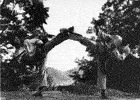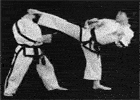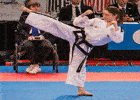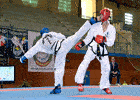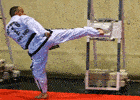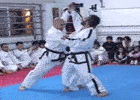Frequently Asked Questions
Q: What should I wear for my
first class?
A: Anything you feel comfortable
in! For children just something similar to their PE kit is fine. Adults
should wear suitable clothing for exercise.
Q: Are the classes female friendly?
A: Yes. we have a good mix of males and females throughout all our classes.
Q: Do I need any previous experience?
A: No, beginners are always very welcome in our classes. You will find a very supportive environment within the
class that will enable you to progress at a pace that builds a solid foundation of skills..
Q: Are any grades or skills that I achieve in the classes only recognised at the club or locally?
A: No. Parallax Taekwon-Do is a member of the International Taekwon-Do Federation (ITF), a World recognised
professional organisation. Any grades that you achieve will be recognised
worldwide, the ITF also provides the opportunity to participate in
events and competions internationally.
Q: Are your Instructors Working with Children Checked?
A: Yes. All our Instructors are Working with Children certified. Our WWC numbers and relevant details
can be given on request.
Q: Are your Instructors first aid trained?
A: Yes. All our Instructors are first aid certified. We attend regular courses to keep our skills updated.
Q: Can I bring something to drink during the class?
A: Yes, we highly recommend that you bring either a bottle of water or a sports drink of your choice. It is very important
that you keep yourself hydrated during exercise. Regular water breaks are given during the class, or you are free
to take on water when you require.
Q: What time should I arrive for the class?
A: We ask that students try to
arrive at least 10 minutes before the start. This avoids disruption
to classes in progress and allows you to take part in the warm up,
which physically prepares you for the fitness portion of the class.
Q: Will martial arts classes make my child aggressive or violent?
A: Quite the opposite. Children
who have a positive outlet for their energy, who are taught self-control
and who participate in activities that boost their confidence and
self esteem, have proven to be calmer, less prone to violent outbursts
and more adept at resolving conflict without becoming physical. They
are also taught to understand that with acquired skills comes responsibility.
Q: What age is too young or too old to join?
A: We enroll students in our classes from the age of 6 years old. I have seen many people start
Taekwon-Oo at a later age, even up to 70 years old. There are so many ways that you can benefit
both physically and mentally from the practice of Taekwon-Do, no matter what age!
Q: Will I have to spar or compete at competitions?
A: Sparring is a part of Taekwon-Do.
however, we make sure sparring is practiced in a controlled and safe
environment. We never allow our students to be put in a dangerous
situation. We attend many competitions throughout the year and it
is the students choice if they would like to compete. There are many
aspects of Taekwon-Do that students can benefit from, ranging from the fitness aspect through to
gaining self confidence. Competing is not essential and we will never
pressure students to compete.
Q: Do I need to purchase a uniform straight away?
A: No, You do not need to purchase a Dobok (practice suit) straight away. But you are required to have one
after your first grading, which is usually around 3 months after you start training.
Contact Details
Marc Fitzsimons
VI Degree
International Instructor & Examiner
0444 565 400
info@parallaxtkd.com.au
What Does Taekwon-Do Offer You?
Taekwon-Do can give you the ability and confidence to defend yourself powerfully and effectively. Whilst learning the various techniques you will
also be developing a high level of fitness, flexibility and self-discipline. Rarely does another martial art offer the same strong blend of intense
body conditioning and defensive skill development. Training in Taekwon-Do is very enjoyable and can bring with it a range of benefits:
Self-defence skills - You will learn basic and advanced offensive
and defensive skills which will increase your ability to defend yourself from attack by one or more opponents. Significant training time is spent on
defending against knives and other hand weapons, and against multiple opponents.
Moral code - Courtesy and respect toward others is an important part
of training. Mental and spiritual development goes hand-in-hand with physical training in Taekwon-Do.
Improved health & fitness - Taekwon-Do sessions
contain cardiovascular workouts, callisthenics, endurance training and all over strength development. This promotes weight loss, muscle development and suppleness.
Confidence and self discipline - Almost all people training in Taekwon-Do say that their
confidence has improved and that this positivity extends beyond training into other areas of their lives.
Social interaction - Getting the most from
Taekwon-Do is often about group spirit and teamworking with other students to develop your skills. Mutual encouragement and the intensity of training
makes for a friendly and positive class environment.
Taekwon-Do classes are generally 1-1:30 hours in duration. Special training classes and seminars may be longer. The classes are generally split
into 2 or 3 phases with the first phase almost always being a warm-up/fitness regime. Training may be pad-work, patterns, technical kicking, blocking,
weapon-defence, grappling, sparring and various other types of training to develop technique, accuracy, speed and power. Clothing should be loose-fitting
and stretchable - for example tracksuit bottoms and T-shirt - and no footwear is required.






